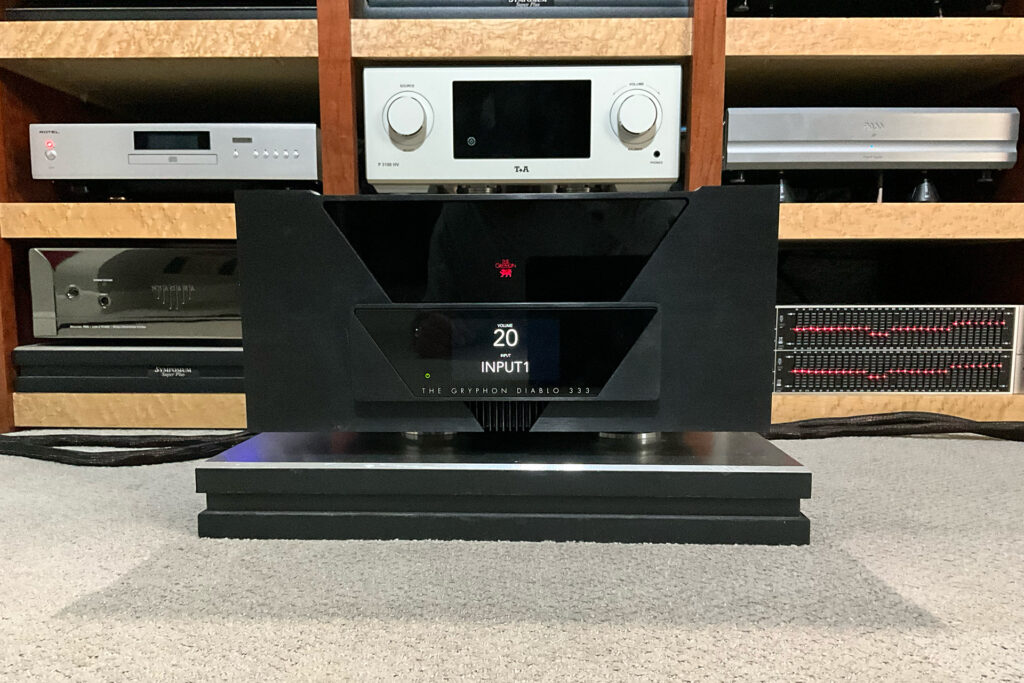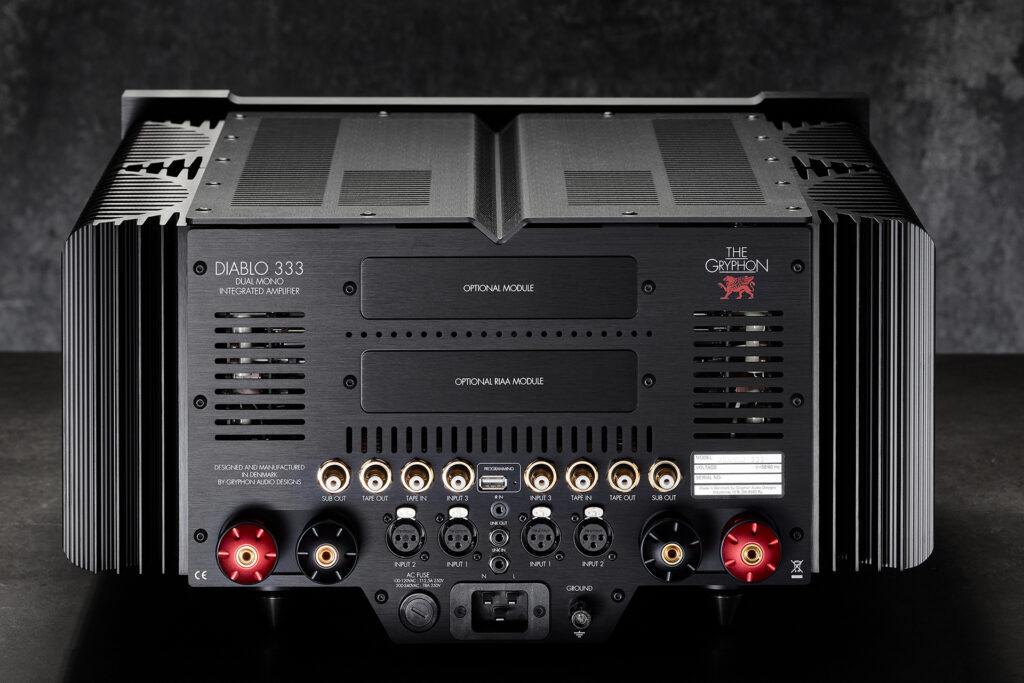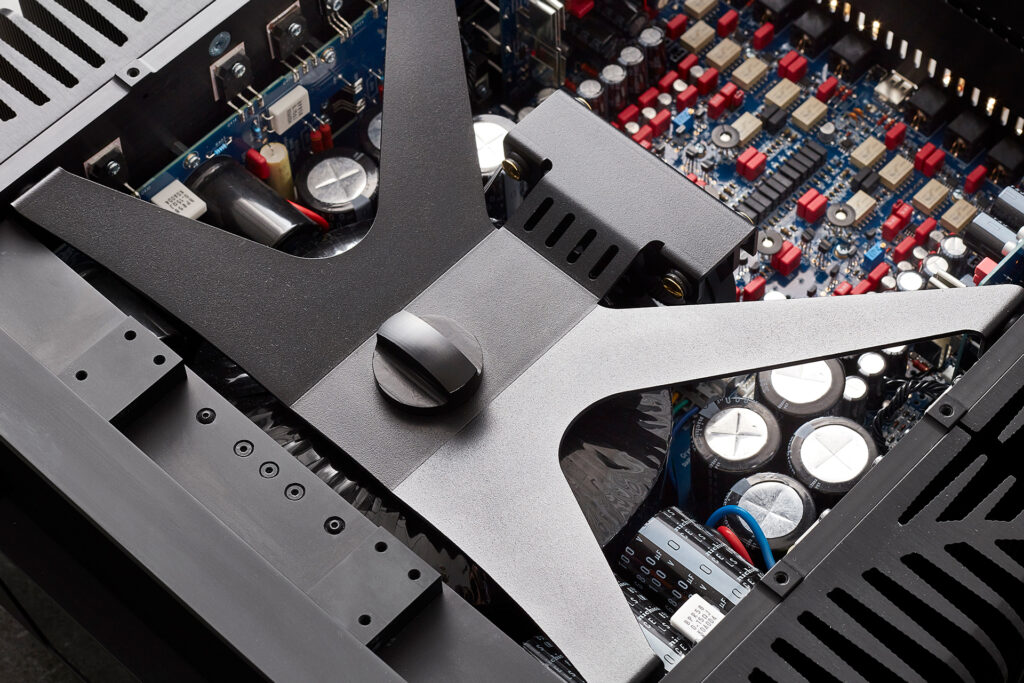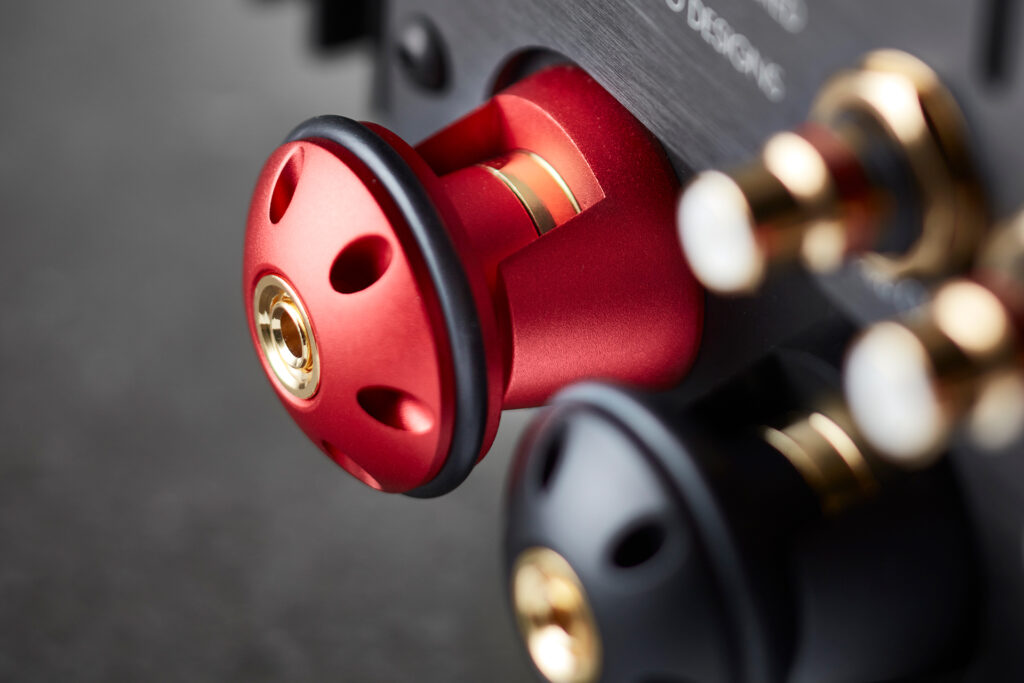Gryphon Audio was founded in Denmark in 1985 by Mr. Flemming Erik Rasmussen and has, since its inception, assiduously and unapologetically pursued audiophile excellence with the goal of becoming and maintaining what it terms as an aspirational brand. Rasmussen, himself a devotee of the arts, headed the aesthetic design of all Gryphon products and brought to bear the Nordic Noir black-on-black styling for which Gryphon is now universally known. After 33 years at the helm, Rasmussen recently retired and his last aesthetic styling contribution was on the Diablo 333.
Being an aspirational brand means the product lineup is basically devoid of what may be termed as budget or entry-level products. In fact, the top-tier Gryphon Apex Stereo Amplifier, priced at $104,500 (the Apex monoblocks are $104,500 each), is just over three feet in length and tips the scales at a mere 445 pounds. This amp would certainly be considered aspirational. The Diablo 333 is very competitively designed and priced with other integrated amps in its class. And while easily more expensive than any budget or entry-level integrated, what the Gryphon Diablo 333 brings to the party is exceptional design, build quality and sonic excellence. In fact, some of the technology utilized in the flagship Apex Amplifier and Commander Preamp family of components are also used in the Diablo. Because of their reputation, I was thrilled to be offered the Gryphon Diablo 333 for review. First, I wanted to see if all the buzz surrounding Gryphon as a brand was justified. And secondly, reviewing another integrated amp would certainly further my mission in answering a question I feel the audiophile community is now asking – will an integrated component offer world-class sonic excellence while commensurately moving closer to the goal of more components in fewer boxes? Or, conversely, are separates still the preferred path and one-box solutions not yet a true audiophile product? Let’s look and see if the Gryphon Diablo 333 may help answer this question.

What Makes the Gryphon Diablo 333 Integrated Amp So Special?
- The Gryphon Diablo 333 is a Class-A/B solid state integrated amplifier of the highest magnitude. It operates in Class-A through about the first 10 watts, then switches to Class-A/B for hundreds and hundreds of watts after that.
- The 333 in the name is not by accident. This amplifier features 333 watts per channel at eight ohms and 666 watts per channel at four ohms. With this considerable level of power, driving almost any modern speaker system in existence will be very simple.
- The Gryphon Diablo 333 features plus-38 dB of gain. This means the volume can or will get very loud, very quickly. With the volume set to a mere 20 on the front faceplate (it goes much higher), I realized 80 to 85 decibels of in-room sound, which is my normal listening level. Accordingly, having such a surplus of power for any measure of increased wattage requirements is in no way a concern. Playing musical passages with a wide dynamic range at rock concert levels should not be an issue at all.
- In what is presumed to be a furtherance of the one-box solution concept, Gryphon has slots on the rear of the component for both a DAC and phonostage modules. Having this capability better utilizes the all-in-one model and reduces space requirements, number of components and a reduced wiring path for a fully fleshed-out system. Probably best of all, it also reduces the cost over separates. Pricewise, the DAC 3 Module retails for $7,600 and the PS 3 Phonostage Module is $6,000. Both are either factory or dealer-installed.
- There are a total of four source inputs, in addition to the optional modules. Two inputs are unbalanced, or RCA, and two are balanced, or XLR.
- Other connection options are dual subwoofer outputs, a tape loop, a USB port for firmware updates and both 12V DC inputs and outputs. One of the RCA inputs may be configured for Unity Gain and Home Theater throughput. As for speaker connections, Gryphon employs custom-designed gold-plated binding posts, which accept both spade and banana terminals.
- The Gryphon Diablo 333 is designed as a true input-to-output balanced component.
- In keeping with its aesthetic design, the Gryphon Diablo 333 does not have any knobs or other similar front-mounted controls. The power button is even located just under the front faceplate and is easily accessed. It does have a 4.3-inch capacitive touch, triangular-shaped front touchscreen, which is used to access all the various controls. I found the menus to be logically laid out and mostly simple and straightforward to navigate.
- The four sources can be customized to a specific name. Source three, for instance, can be renamed as CD Player. If the DAC or phonostage modules are used, they will show up as their respective names on the front screen by default.
- Volume attenuation is performed by 43-step, microprocessor-controlled, true-balanced volume attenuation.
- The Gryphon Diablo 333 is designed with Zero Global Negative Feedback, which helps to provide a more open, natural and dynamic sound. Negative feedback is also helpful in creating an uncolored sonic presentation.
- Build quality is exceptional. In addition to its 112-pound weight, the Gryphon Diablo 333 also has large heatsinks on each side for temperature management.
- A machined aluminum remote is included. Like the amp itself, the remote is black with white buttons.

Why Should You Care About the Gryphon Diablo 333?
Gryphon Audio is known worldwide as a maker of very high-end audiophile electronics. They have amplifiers, which very likely need a dedicated electrical service and a large space to make them feasible. We all want quality sound and there are certainly a wide range of budgets in which to procure an audio system. While not an entry-level component, the Gryphon Diablo 333 displays stellar performance and provides a truly world-class design ethos in a user-friendly product from both an operational and a logistical standpoint. It may even be considered a cost-saving component due to the elimination of multiple ancillary gear used in the average audiophile system. Anyone looking for an entry-level lifestyle product will absolutely consider the Gryphon Diablo 333 as a significant overspend. However, combining this level of design excellence, a proven world-class, best of the best reputation, and the collective features and benefits, the Gryphon Diablo 333 may well be considered by many as an affordable value which also delivers outstanding sonics.

Some Things You Might Not Like About the Gryphon Diablo 333 …
- Unlike a growing number integrated amplifiers from other audiophile manufacturers, the Diablo 333 does not include streaming.
- There are only two RCA inputs and two XLR inputs on the Gryphon Diablo 333. To be fair, the aforementioned spaces for a Gryphon DAC and phonostage module will accommodate most audio systems’ source components. Utilizing both modules, two RCA and two XLR inputs should be more than sufficient for any additional sources unless you have an awful lot of analog inputs. Factor in the concept that this audiophile integrated amp also can come with an internal, high quality DAC as well as a comparable high end phonostage, you are likely OK on inputs with the Diablo 333.
- This is a fairly large, heavy, integrated amplifier. At a weight of 112 pounds, it is best moved by two people. And at just over 18 inches long, 18 inches deep and over nine inches tall, fitting it in a rack may be difficult. Confined space rack-mounting may also affect cooling. Since I always place an amplifier on a stand or platform on the floor, neither of these conditions were relevant.
- For those who prefer their own aftermarket audiophile power cord, the male plug on the back of the unit is an IEC 20A configuration. Standard IEC 15A female-end cords will not work but you can order one from any reputable audiophile cable manufacturer that will work.

Listening With the Gryphon Diablo 333 Integrated Amplifier
Because my unit was a review sample, Gryphon requested I play music nonstop for a minimum of 24 hours before any critical listening. Because of other things I was doing at the time, I actually gave it four days. This proved to be a beneficial exercise because, after my exile, I found several very obvious improvements as compared to when I first powered on the amplifier.
Immediately noticeable was the bass response. I am not sure I have ever heard tighter, more controlled bass on my system in my audio room – ever. Try though I might, I could not detect one iota of boominess, low frequency smear or congestion on any tracks I initially played. Bass guitars, kick drums and similar instruments had a demonstrably and sharply presented sonic impact and sounded amazingly natural yet quite powerful. I was also very impressed with the high frequencies on the Gryphon Diablo 333. Cymbals had a lingering attack and decay like you hear in a live musical event but rarely hear in an audiophile system. And when the drumstick hit the brass, there was a noticeable crack that created the attack and then the decay took over. On alto saxophones, for instance, when the musician hit a high note and held it, the presentation was razor-sharp and had no grainy or fuzzy texture to the note. As for the midrange, it was likewise outstanding. Because so much of the musical presentation lives in those middle frequencies, having a clean, clear, yet dynamic midrange is always highly desired. I found having the dynamic intensity and power through all three frequency ranges actually made me pay closer attention to the music. Regarding clarity and accuracy, both were commensurate with what a component in this class should deliver. Sonically, this is a component that does a lot of things very, very well. Basically, the sonics on the Gryphon Diablo 333 are fantastic. However, I did find the Gryphon Diablo 333 to be mostly analytical and very, very neutral. I doubt this device imparts any sonic flavor of its own.
On the 1980 release of Autoamerican by Blondie, Debbie Harry tries her hand at rap on the track “Rapture.” At the start of the track, the drum was quite concussive and supports the overall excellence in bass management. When the synth and guitars came in, the dynamics and musicality were captivating. The Diablo 333 made this early portion of the track very powerful, and this continued until the song’s end. The vocals, placed front and center, were effortlessly portrayed, perhaps lending to the somewhat dreamy nature of the song. “Rapture” was released in the early days of rap, and Harry, ever the pioneer, does what I feel was a very acceptable job with the genre in those days. This song has a somewhat wistful, futuristic quality anyway, and the Gryphon Diablo 333 was able to portray this sonic quality.
Classifying Sugarland as a strictly country band is not exactly correct. They are a mix of country, rock and pop and, with the powerhouse vocals of Jennifer Nettles, and the accompaniment of Kristian Bush on guitar, mandolin and other stringed instruments, as well as vocals, this duo has become one of my favorites. On the track “Love,” from the release Love On the Inside, Nettles and Bush really turn things loose. With Nettles’ immense vocals, and the ability to effortlessly vary the pitch, tone, amplitude and sheer power of her voice in the same breath, this song has the ability to make the hair stand up on the back of one’s neck. The Gryphon Diablo 333 transformed what might otherwise be the simple strumming of an acoustic guitar into something that might truly be physically felt. I could actually hear the force of Bush’s fingers hitting the strings on the acoustic guitar. At the same time, Nettles’ voice is clear and very forceful. Songs like this live for dynamic power, and the Diablo does not disappoint. At about the three-minute mark, Bush lets go with some vocal fury of his own, and both singers are belting it out separately. Easily heard in full measure are an electric guitar, bass and drums. Anyone who is unsure what dynamic power sounds like should hear this song with the Gryphon Diablo 333 at the helm. Very impressive.
Will the Gryphon Diablo 333 Integrated Amp Hold Its Value?
Given the cost of this component, and the presumed value of the system into which it is used, I would expect the Diablo 333 will not come up for sale on the used market very often. If it does, it might very likely be because the level of the system’s components is being dramatically upgraded. For most, given the level of high-quality sonics this integrated will deliver, I see most users holding onto the Gryphon Diablo 333 for a long time or until a new version is released. For this reason, I expect the overwhelming percentage of owners will view the Gryphon Diablo 333 as a definite value-oriented purchase.

What is the Competition for the Gryphon Diablo 333 Integrated Amplifier?
A name not so well-known in the United States is Vitus Audio. This Danish company makes products costing up to just under a stratospheric $400,000. However, the Vitus Audio R1-101 MKII retails for $21,250 and, with the optional $5,000 DAC/Streaming Module, the cost increases to $26,250. In fact, the Vitus Integrated shares quite a bit of technology with the Gryphon Diablo 333. Vitus also utilizes all discrete circuitry, 300 WPC into eight ohms and 600 WPC into four ohms. No stranger to design, the Vitus Audio Integrated comes in a very flashy Titanium Orange color. Streaming is not included.
Another world-class brand is the Boulder 866 Integrated which retails for a cost of $15,000.While much less than the Diablo and even less than the average Boulder product, it is still a world-class device made by one of the best high-performance audio manufacturers on the planet. Featuring 250 WPC into eight ohms and 400 WPC into four ohms, multiple inputs including XLR, AES/EBU, USB, TosLink, full Roon integration and a color front touchscreen, the Boulder 866 can serve as the hub for a high-end yet somewhat consolidated system. It also does not, however, include streaming capabilities.
Firmly positioned in the very similar column is the T+A PA 3100 HV Integrated Amplifier (read review here). This component and the Gryphon Diablo 333 are more alike than dissimilar. While the T+A is slightly less powerful, 300 WPC into eight ohms (380 WPC peak) and 500 WPC into four ohms (700 peak), the T+A PA 3100 HV does have a few notable differences. Like all products in the HV series, the PA 3100 HV utilizes high voltage on the power supply rails to recreate what tube amps do naturally. The T+A PA 3100 HV thoughtfully includes four inputs in both XLR and RCA and two additional inputs in RCA only. One of the RCA inputs can be configured as a tape monitor. T+A also includes tone controls and onboard room correction. An optional phono module is available. Sonically, both are, again, very similar. I would give the Gryphon Diablo 333 the nod when it comes to bass response – seriously, it is that good. Both are quite analytical in their overall presentation. However, when considering sonic comparisons, both integrated amps sound surprisingly similar.

Final Thoughts on the Gryphon Diablo 333 Integrated Amplifier …
All throughout my evaluation I kept asking myself one simple question – could this integrated serve as my amp/preamp, as opposed to separate components? My immediate answer is yes, absolutely. I find the sonics on the Gryphon Diablo 333 to render an excellent sonic picture. Had I started out with this combo integrated and not with separates, I’m not exactly sure I would even consider ever changing.
Sonically, however, I’d still have to give the overall edge to my T+A A 3000 amp, T+A P 3100 HVpreamp, Bricasti M21 Platinum DAC and Pass Labs XP-27 phonostage separates. My reference components have noticeably better imaging and, while exuding an equal amount of dynamic power, and slightly better clarity, they offer a certain tangible sense of emotional connection all audiophiles cherish. However, the difference between my T+A gear and the Gryphon Diablo 333 is very small. And of course, the retail cost of my amp, preamp, DAC and phonostage is significantly more expensive than the Gryphon Diablo 333, yet they sound more alike than I would have ever guessed. My observations are easily based on my own personal preferences. In fact, my audiophile friend Mark actually prefers the marginally more laid-back, very analytical sound of the Gryphon Diablo 333 over my T+A separates. This difference, ever so minor in nature, may be summarized by two criteria – how the components were voiced and personal preference. My observations are just that, observations and not a condemnation of the Diablo’s performance in any way. As I’ve said many times, some like Chevy and some like Ford.
The Gryphon Diablo 333 is a seriously well-designed, well-executed audiophile integrated amp and preamp. It could easily be the linchpin in a very high-quality audio system capable of superior sonics. It has the power, dynamics, bass, midrange and treble qualities audiophiles want, as well as excellent clarity and accuracy. With its stylish good looks (as long as the user likes black), it may easily become the focal point of any audio system. And best of all, it is a component that will bring years of high-quality sonics, making it an even better value.
I realize the fact that there are those who view this component as too expensive, and so does Gryphon. They call themselves an aspirational brand on purpose. Anyone who has the means and desire for an amp and preamp combo on this level should give the Gryphon Diablo a serious look. If it impresses you as it did me, it sure makes for an interesting choice in building an audio system. My own personal bottom line? I still prefer separate components, regardless of the cost. But I must admit, the Gryphon Diablo 333 is one of the very few integrateds I have heard that seriously challenges my own partialities. To date, it is hands-down the best integrated amplifier I have had in my audio system. There are more good ones coming, but this is the best so far.



